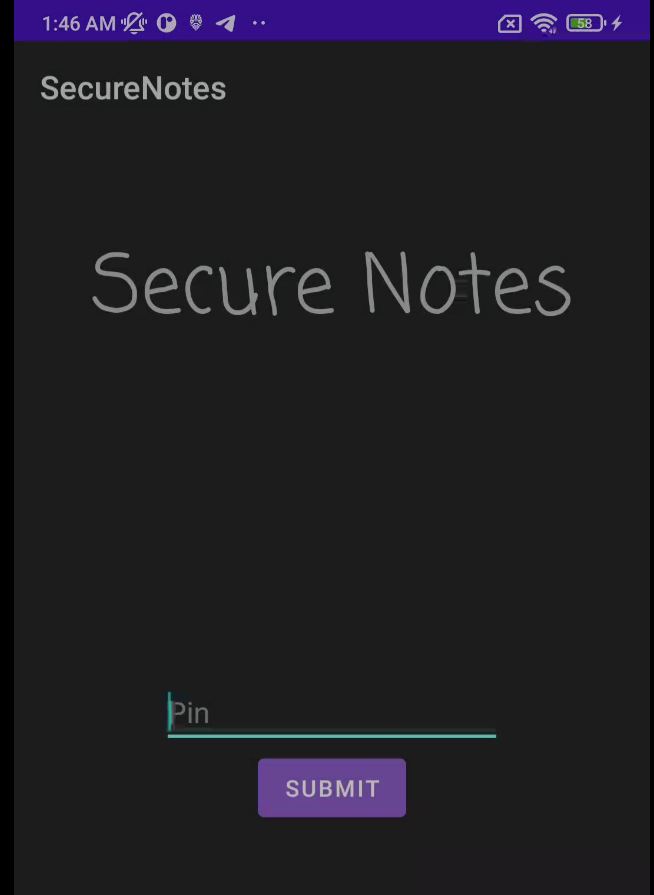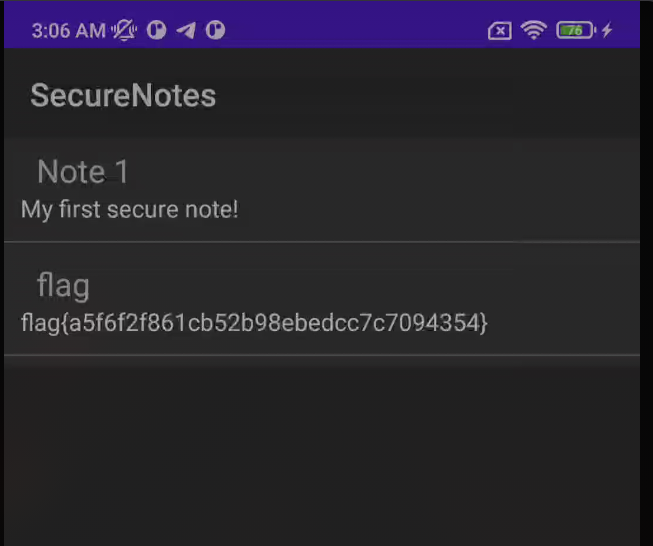NahamCon CTF 2022 - Secure Notes¶
Description: None of the free note taking app offer encryption... So I made my own!
Download: https://lautarovculic.com/my_files/secure_notes.apk
Install the APK file with ADB
We can see that we need insert a 4-Digit PIN.
If we insert any number, we get the Wrong password message.
Let's inspect the source code using jadx.
The package name is com.congon4tor.securenotes.
We have two activities in AndroidManifest.xml file:
-
LoginActivity-> MainActivity also?¿?¿ -> PIN Screen -
MainActivity-> Just the "Menu screen app".
<activity
android:name="com.congon4tor.securenotes.LoginActivity"
android:exported="true">
<intent-filter>
<action android:name="android.intent.action.MAIN"/>
<category android:name="android.intent.category.LAUNCHER"/>
</intent-filter>
</activity>
<activity
android:name="com.congon4tor.securenotes.MainActivity"
android:exported="true">
<intent-filter>
<action android:name="android.intent.action.MAIN"/>
<category android:name="android.intent.category.LAUNCHER"/>
</intent-filter>
</activity>
This is controversial, and I don't know if it is intentional.
Because we have two activities that have the category of LAUNCHER. This can cause problems when running the application in recent versions of Android, because both activities will appear in the “Home” of the device.
This behavior officially not supported but allowed, and in certain versions of Android (depending on the launcher) it can:
-
Show two separate app icons.
-
Break the normal launcher flow.
-
Generate conflicts with
taskAffinity,backstackor intent routing. -
In older launchers it directly causes an activity to never appear.
If you have problems starting the application, you can use the following ADB command:
Let's continue with the challenge.
After search in strings.xml file, I didn't find nothing.
So, it's time for java code.
Starting as probably the flow is, let's start with LoginActivity code.
Here's a declaration of variables:
public ViewOnClickListenerC0320a(TextView textView, File file, Intent intent) {
this.f2153b = textView;
this.f2154c = file;
this.f2155d = intent;
}
The textView is the PIN input.
We have the onClick() method:
public void onClick(View view) {
try {
C0590d.m2126k(this.f2153b.getText().toString() + this.f2153b.getText().toString() + this.f2153b.getText().toString() + this.f2153b.getText().toString(), new File(this.f2154c.getPath()), new File(LoginActivity.this.getCacheDir(), "notes.db"));
LoginActivity.this.startActivity(this.f2155d);
} catch (C0596a unused) {
Toast.makeText(LoginActivity.this.getApplicationContext(), "Wrong password", 0).show();
}
}
notes.db file. So, the AES key is PINPINPINPIN.
Also we have
Intent intent = new Intent(this, (Class<?>) MainActivity.class);
File file = new File(getCacheDir() + "/db.encrypted");
if (!file.exists()) {
try {
InputStream open = getAssets().open("databases/db.encrypted");
byte[] bArr = new byte[open.available()];
open.read(bArr);
open.close();
FileOutputStream fileOutputStream = new FileOutputStream(file);
fileOutputStream.write(bArr);
fileOutputStream.close();
} catch (Exception e2) {
throw new RuntimeException(e2);
}
}
db.encrypted file that will try to decrypt for get the notes. The file can be pulled from device but if you have a non-rooted device, then just decompile the APK with apktool
Inside of /assets/databases directory you will find the db.encrypted file.
Notice that in my case, the class where the decrypt take place, is C0590d.
public static void m2126k(String str, File file, File file2) {
try {
SecretKeySpec secretKeySpec = new SecretKeySpec(str.getBytes(), "AES");
Cipher cipher = Cipher.getInstance("AES");
cipher.init(2, secretKeySpec);
FileInputStream fileInputStream = new FileInputStream(file);
byte[] bArr = new byte[(int) file.length()];
fileInputStream.read(bArr);
byte[] doFinal = cipher.doFinal(bArr);
FileOutputStream fileOutputStream = new FileOutputStream(file2);
fileOutputStream.write(doFinal);
fileInputStream.close();
fileOutputStream.close();
} catch (IOException | InvalidKeyException | NoSuchAlgorithmException | BadPaddingException | IllegalBlockSizeException | NoSuchPaddingException e2) {
throw new C0596a("Error encrypting/decrypting file", e2);
}
}
The notes.db is formatted in JSON (See MainActivity)
try {
JSONArray jSONArray = new JSONObject(stringBuffer.toString()).getJSONArray("notes");
for (int i3 = 0; i3 < jSONArray.length(); i3++) {
JSONObject jSONObject = jSONArray.getJSONObject(i3);
arrayList.add(new C0614b(jSONObject.getInt("id"), jSONObject.getString("name"), jSONObject.getString("content")));
}
}
We just need brute-force the PIN. And then, extract the notes.db file.
Here's a python script that do the work:
from Crypto.Cipher import AES
from Crypto.Util.Padding import unpad
import json
def try_decrypt(key_str, input_path="db.encrypted"):
key_bytes = key_str.encode('utf-8')
cipher = AES.new(key_bytes, AES.MODE_ECB)
with open(input_path, "rb") as f:
encrypted = f.read()
try:
decrypted = cipher.decrypt(encrypted)
decrypted = unpad(decrypted, AES.block_size) # PKCS5/7 padding
decoded = decrypted.decode('utf-8')
obj = json.loads(decoded)
return obj
except Exception as e:
return None
for i in range(10000):
pin = str(i).zfill(4)
key_str = pin * 4 # same app logic
result = try_decrypt(key_str)
if result and "notes" in result:
print(f"[+] PIN: {pin}")
with open("notes.db", "w", encoding="utf-8") as f:
json.dump(result, f, indent=2)
break
else:
print("[-] No valid PIN.")
Then, cat the notes.db and get the flag!
Flag: flag{a5f6f2f861cb52b98ebedcc7c7094354}
I hope you found it useful (:

